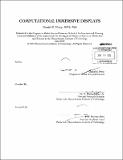Computational immersive displays
Author(s)
Novy, Daniel E. (Daniel Edward)
DownloadFull printable version (8.527Mb)
Other Contributors
Massachusetts Institute of Technology. Department of Architecture. Program in Media Arts and Sciences.
Advisor
V. Michael Bove, Jr.
Terms of use
Metadata
Show full item recordAbstract
Immersion is an oft-quoted but ill-defined term used to describe a viewer or participant's sense of engagement with a visual display system or participatory media. Traditionally, advances in immersive quality came at the high price of ever-escalating hardware requirements and computational budgets. But what if one could increase a participant's sense of immersion, instead, by taking advantage of perceptual cues, neuroprocessing, and emotional engagement while adding only a small, yet distinctly targeted, set of advancements to the display hardware? This thesis describes three systems that introduce small amounts of computation to the visual display of information in order to increase the viewer's sense of immersion and participation. It also describes the types of content used to evaluate the systems, as well as the results and conclusions gained from small user studies. The first system, Infinity-by-Nine, takes advantage of the dropoff in peripheral visual acuity to surround the viewer with an extended lightfield generated in realtime from existing video content. The system analyzes an input video stream and outpaints a low-resolution, pattern-matched lightfield that simulates a fully immersive environment in a computationally efficient way. The second system, the Narratarium, is a context-aware projector that applies pattern recognition and natural language processing to an input such as an audio stream or electronic text to generate images, colors, and textures appropriate to the narrative or emotional content. The system outputs interactive illustrations and audio projected into spaces such as children's rooms, retail settings, or entertainment venues. The final system, the 3D Telepresence Chair, combines a 19th-century stage illusion known as Pepper's Ghost with an array of micro projectors and a holographic diffuser to create an autostereoscopic representation of a remote subject with full horizontal parallax. The 3D Telepresence Chair is a portable, self-contained apparatus meant to enhance the experience of teleconferencing.
Description
Thesis (S.M.)--Massachusetts Institute of Technology, School of Architecture and Planning, Program in Media Arts and Sciences, 2013. Cataloged from PDF version of thesis. Includes bibliographical references (p. 77-79).
Date issued
2013Department
Program in Media Arts and Sciences (Massachusetts Institute of Technology)Publisher
Massachusetts Institute of Technology
Keywords
Architecture. Program in Media Arts and Sciences.